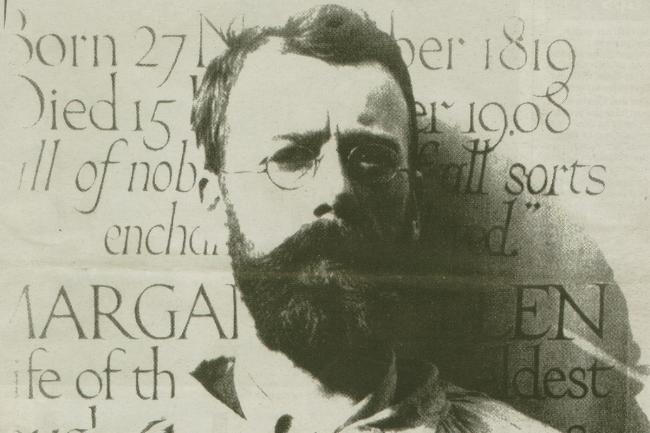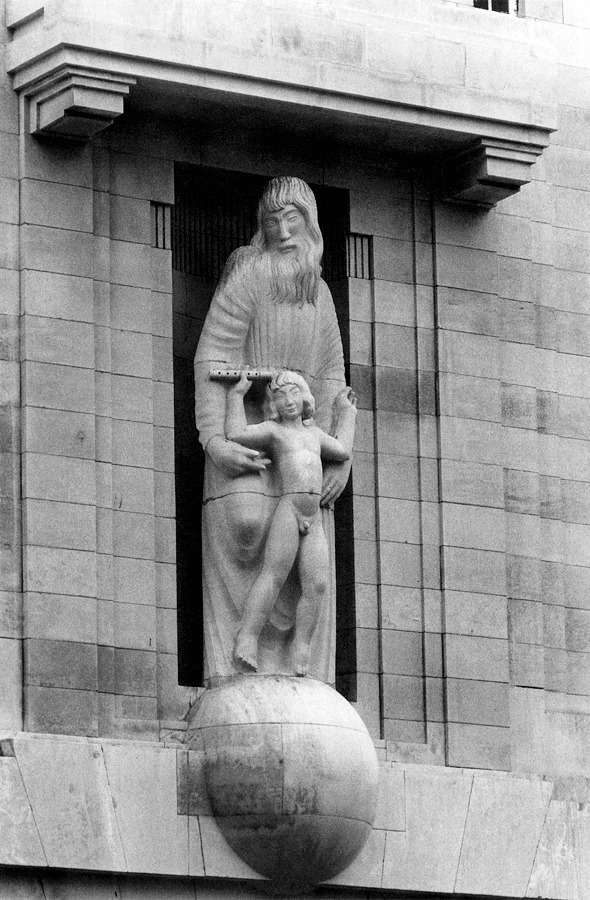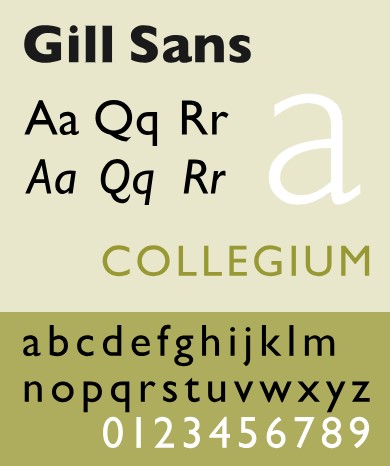- Born 1882, Died 1940
- Guild member (founder) 1920 – 1924
- Stone cutter, letterer, drawer, engraver, sculptor, font-designer, architect, writer
Table of Contents
Introduction
Writing about Eric Gill is not an easy matter, he was a complex and contradictory man about whom much has been written already, a great deal of which is accessible elsewhere on the internet. There is also a great deal elsewhere on this site, as he was so instrumental in founding the Guild and developing its ideas.

Life
Early life: 1882-1900
Gill was born in 1882 in Hamilton Road, Brighton, the second of the 13 children of (Cicely) Rose King (d. 1929), formerly a professional singer of light opera under the name Rose le Roi, and Rev. Arthur Tidman Gill, minister of the Countess of Huntingdon’s Connexion, who had recently left the Congregational church, after doctrinal disagreements. In 1897 the family moved to Chichester.
Pre Guild: 1900-1920
Gill studied at Chichester Technical and Art School, and in 1900 moved to London to train as an architect with the practice of W. D. Caröe, specialists in ecclesiastical architecture. Frustrated with his training, he took evening classes in stone-masonry at the Westminster Technical Institute and in calligraphy at the Central School of Arts and Crafts, where he was taught by Edward Johnston, creator of the London Underground typeface, who became a strong influence. In 1903 he gave up his architectural training to become a calligrapher, letter-cutter and monumental mason.
Abandoning early training as an Architect, he took to lettering and stone carving in his early twenties. A move to Hammersmith 1905 led to friendship with Edward Johnson and Hilary Pelper, something which was to continue when Gill, seeking a rural environment, moved to Ditchling in 1907. There his ideas continued to develop along with his artistic reputation; he was received into the Catholic Church in 1913 and soon afterwards was awarded the commission for the Stations of the Cross in Westminster Cathedral, the brilliant realisation of which was to establish his pre-eminence among contemporary sculptors.
Guild: 1920-1924
The founding of the Guild and Gill’s early departure are described in the history section of this site.
Post Guild: 1924-1940
His growing concern with self-sufficiency was the driving force behind the foundation of the Guild in 1921, while his restless nature led to its first crisis when he left to found a new community in the remote Welsh hamlet of Capel y ffin in 1924. Gill never fully settled there and returned to the South East in 1928 acquiring a farm property called Piggotts, close to North Dean, 4 miles north of High Wycombe. As elsewhere, he lived and worked with other craftsmen, in this case his daughters and two sons-in-law, Denis Teigetmeier and Rene Hague.

His range of work continued to grow throughout his lifetime, encompassing typography, book design, engraving, social campaigning and sculpture. He was rigorously opposed to fascism throughout his life and campaigned for peace prior to World War II.
He died from cancer in 1940 and is buried at Speen Baptist Church
Controversy
His Catholicism however, was some way from being orthodox, his version modifying traditional teaching to permit full reign to his considerable sexual appetites. In this he seems to have been influences by Ananda Coomaraswamy, a Sri Lankan Tamil metaphysician and philosopher of Indian art who was an early interpreter of Indian culture to the West. Coomaraswamy was instrumental in Gill developing ideas about the close relationship between the spiritual and the erotic.
These ideas always made him a problematic figure in Catholic circles, but somehow he managed to charm his way through controversies in his lifetime, and this carried on after his death. This was to change however with the publication of Fiona MacCarthy’s biography which revealed that he was a paedophile who abused his daughters, their maid, had sex with his sisters and even his dog. His was a sexual deviancy on a monumental scale, In the immediate period after these facts were revealed Gill’s reputation as an artist protected him from the worst of the fall-out, aspects his life were now seen to be deplorable but his artistic legacy remained.
As time as passed, however, such a line has become less sustainable. It is now recognised that his conduct, especially in relation to his daughters, was criminal, and that, by rights, he should have served time in prison. It is also more generally argued that this cannot be entirely separated from his art, and his reputation is now irretrievably damaged by his abusive conduct. The Ditchling museum of Art + Craft bravely tackled this subject in some detail at an exhibition called Eric Gill: the Body as well as making a commitment to include at least one display highlighting Gill’s offending in its permanent exhibitions. This article is recommended reading about the topic.
I don’t wish to defend Gill, I regard his conduct as deplorable. But – I feel the need to make the point that he seems never to have received censure from those close to him. His family and close friends, as far as can be judged from their public comments, seem to have seen him as an almost saintly figure. Why this should be, frankly, I don’t understand; the best that can be said for him in my view is that he is an enigmatic figure.
Output
Gil’s output was vast by any standards, taking in numerous forms. This section is merely indicative of the range of his output.
Stone cutting and lettering
After abandoning his training as an architect, Gill first turned to stone cutting and lettering. He continued with this throughout his life and completed thousands of commissions. He is recorded to have worked with great speed, precision and certainty. As his career developed, he often delegated the tasks of cutting letters to his assistants, most frequently Joseph and Laurie Cribb.
Drawings and engravings
Gill was also a prolific drawer and wood engraver, although some critics consider this his least successful medium. Nevertheless, he produced many exquisite small drawings and engravings, especially during his time at Ditchling. Very often these would have explicit erotic content, sadly, even featuring his own daughters, but this was not always the case.

Bas-relief and sculpture
It was in Ditchling that Gill, began direct carving of stone figures in 1910. These included Madonna and Child (1910), which English painter and art critic Roger Fry described in 1911 as a depiction of “pathetic animalism”, and Ecstasy (1911). Such semi-abstract sculptures showed Gill’s appreciation of medieval ecclesiastical statuary, Egyptian, Greek and Indian sculpture, as well as the Post-Impressionism of Cézanne, van Gogh and Gauguin.
His first public success was Mother and Child (1912). Gill was fascinated during this period by Indian temple sculpture and along with his friend and collaborator Jacob Epstein, Gill planned the construction in the Sussex countryside of a colossal, hand-carved monument in imitation of the large-scale Jain structures at Gwalior Fort in Madhya Pradesh, to which he had been introduced by William Rothenstein. This was never realised.
In 1914, Gill produced a magnificent series of bas-reliefs for the stations of the cross in Westminster Cathedral, a commission which was to seal his reputation. He was assisted in this task by Joseph Cribb who did a great deal of the carving to Gill’s designs.

Gill designed several war memorials after the First World War, including the Grade II* listed Trumpington War Memorial, the memorial at Chirkand “the huge lettered wall panel recording 228 names of the fallen in the ante-chapel at New College, Oxford.”. Commissioned to produce a war memorial for the University of Leeds, Gill produced a frieze depicting Jesus driving the money-changers from the temple, showing contemporary merchants as the money-changers, suggesting that the merchants of Leeds had profited from the war.
In 1928–29, Gill carved three of eight relief sculptures on the theme of winds for Charles Holden’s headquarters for the London Electric Railway (now Transport for London) at 55 Broadway, St James’s. He also carved a statue of the Virgin and Child for the west door of the chapel at Marlborough College
In 1932, Gill produced a group of sculptures, Prospero and Ariel, and others for the BBC’s Broadcasting House in London. Soon afterwards, Gill worked on the Art Deco Midland Hotel, built in 1932–33 by the London Midland & Scottish Railway to the design of Oliver Hill. For the project, Gill produced two seahorses, modelled as Morecambe shrimps, for the outside entrance; a round plaster relief on the ceiling of the circular staircase inside the hotel; a decorative wall map of the north-west of England; and a large stone relief of Odysseus being welcomed from the sea by Nausicaa.

In 1934, Gill visited Jerusalem where he worked at the Palestine Archaeological Museum (now the Rockefeller Museum). He carved a stone bas-relief of the meeting of Asia and Africa above the front entrance together with 10 stone reliefs illustrating different cultures and a gargoyle fountain in the inner courtyard. He also carved stone signage throughout the museum in English, Hebrew, and Arabic.
Gill was commissioned to produce a sequence of seven bas-relief panels for the façade of The People’s Palace, now the Great Hall of Queen Mary University of London, which opened in 1936:
In 1938 Gill produced The Creation of Adam, three bas-reliefs in stone for the Palace of Nations, the League of Nations building in Geneva, Switzerland. During this period he was made a Royal Designer for Industry, the highest British award for designers, by the Royal Society of Arts and became a founder-member of the RSA’s Faculty of Royal Designers for Industry when it was established in 1938. In April 1937, Gill was elected an Associate member of the Royal Academy.
Font design
Commissioned by Morison, he designed the Gill Sans typeface in 1927–30. In 1925, he designed the Perpetua typeface for Morison, with the uppercase based upon monumental Roman inscriptions. An in-situ example of Gill’s design and personal cutting in the style of Perpetua can be found in the nave of the church in Poling, West Sussex, on a wall plaque commemorating the life of Sir Harry Johnston. In the period 1930–31, Gill designed the typeface Joanna which he used to hand-set his book, An Essay on Typography.

Architecture
Although Gill had trained as a architect, it was only towards the end of his life, Gill produced his one realised building design, St Peter the Apostle Roman Catholic Church in Gorleston-on-Sea, built in 1938–39 (below).

Writings
- ‘Preface’, in Vivakarma: Examples of Indian Architecture, Sculpture, Painting, Handicraft, Chosen by Ananda K. Coomaraswamy, First Series: One Hundred Examples of Indian Sculpture: With an Introduction by Eric Gill (Messrs. Luzac, 1914), pp. 3-7
- Slavery and Freedom (St Dominic’s Press, 1917)
- Sculpture (St Dominic’s Press, 1918)
- Birth Control (St Dominic’s Press, 1919)
- Dress (St Dominic’s Press, 1921)
- Art and Love ( Lawrence: Golden Cockerel Press, 1928)
- The Future of Sculpture (Monotype Corporation Ltd)
- Art-Nonsense and Other Essays (Cassell & Co. and Francis Walterson, 1929)
- Sculpture and the Living Model (Faber & Faber)
- Art and a Changing Civilisation (John Lane – The Bodley, 1934)
- The Necessity of Belief (Faber & Faber/Hague & Gill, 1936)
- Work & Property (Dent & Sons/Hague & Gill, 1937)
- Twenty-five Nudes (Dent & Sons/Hague & Gill, 1938)
- Autobiography (Jonathan Cape, 1940)
- Trousers & The Most Precious Ornament, (Faber & Faber, 1937)
Radio programme – Portrait of Eric Gill
This is a BBC programme about Gill, produced in 1961, well before Fiona McCarthy’s biography provided the controversial revelations about his sexual activity. Amongst others, it features Joseph Cribb, David Jones, Fr Conrad Pepler, Ewan Gill, and Denis and Petra Tegetmeier.
Gill’s daughters
Gill had three daughters and it must be said out of respect for historic accuracy, none ever complained of being traumatised or damaged by his sexual activities. Damage may, of course, be suppressed so we can never be certain of the full picture. His daughters, all of whom married connections of Gill, were:
Betty, born 1905. Married Hilary’s son David against Eric’s wishes around 1938. David died in 1934, leaving three children. Betty went to live at Capel-y-ffin and married again, to Harley Williams in 1938 with whom she had a further four children. She died in 1956; her daughter by David, Mary, founded a pony-trekking business in Capel y ffn, now managed by her own daughter, Jessica.
The second daughter, Petra, was born on 1906. She became engaged to David Jones at Ditchling, but this was broke off soon after the move to Capel. She then became engaged to Denis Tegetmeier, another Gill associate, who became a graphic artist . After the Capel venture folded, she moved with Gill to Pigotts where she spent the rest of her life, apparently in warm contentment. She lived to 1999. Obituary
Gill’s third daughter Joan, was born 1910. When the family arrived at Capel-y-ffin she met René Hague who was temporarily resident there. The fell in love and later married, immediately becoming part of Gill’s artistic circle and also living at Piggots. Hague became a writer and printer, his most famous book being Dai Greatcoat, the selected letters of his close friend David Jones.
Further information
Media
https://www.bbc.co.uk/archive/night-waves–eric-gill/z766kmn
Links
- https://www.apollo-magazine.com/eric-gills-fall-from-grace/
- https://www.theguardian.com/artanddesign/2017/apr/09/eric-gill-the-body-ditchling-exhibition-rachel-cooke
- https://en.wikipedia.org/wiki/Eric_Gill
- https://catholicherald.co.uk/eric-gill-a-moral-problem/
Bibliography
- Fiona MacCarthy- Eric Gill (Faber & Faber, 1989)
- Donald Attwater – A Cell of Good Living: The Life, Works and Opinions of Eric Gill (Geoffrey Chapman, 1969)
- Donald Attwater – Eric Gill: Workman (James Clarke & Co., 1941)
- Ruth Cribb and Joe Cribb – Eric Gill: Lust for letter and & line (2011)
- Ruth Cribb and Joe Cribb – Eric Gill and Ditchling: The Workshop Tradition (2007)
- Judith Collins – Eric Gill: Sculpture (Lund Humphries, in association with Barbican Art Gallery, 1992)
- Judith Collins – Eric Gill, the Sculpture: A Catalogue Raisonné ( The Herbert Press, 1998)
- Ewan Gill – Bibliography of Eric Gill (Cassell & Co., 1953)
- Ewan Gill – The Inscriptional Work of Eric Gill: An Inventory (Cassell & Co, 1964)
- JF Physick – The Engraved Works of Eric Gill (Victoria & Albert Museum, 1963)
- David Jones – Epoch and Artist (Faber & Faber, 1959)
- David Peace – Eric Gill: The Inscriptions (The Herbert Press, 1994)
- JKM Rothenstein – Eric Gill (Jonathan Cape, 1927)
- Walter Shewering, (ed.) – The Letters of Eric Gill (Jonathan Cape, 1947)
- Christopher Skelton – The Engravings of Eric Gill (Skelton’s Press, 1983)
- Robert Speaight – The Life of Eric Gill (Methuen, 1966)
- Joseph Thorp – Eric Gill (Jonathan Cape, 1929)
- Malcolm Yorke – Eric Gill: Man of Flesh and Spirit (London: Constable, 1981)

